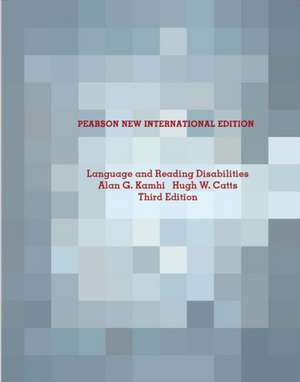Language and Reading Disabilities
Autor Alan Kamhi, Hugh Cattsen Limba Engleză Paperback – 9 aug 2013
Preț: 439.83 lei
Preț vechi: 505.55 lei
-13% Nou
Puncte Express: 660
Preț estimativ în valută:
84.17€ • 87.13$ • 71.14£
84.17€ • 87.13$ • 71.14£
Carte disponibilă
Livrare economică 13-27 februarie
Livrare express 29 ianuarie-04 februarie pentru 41.91 lei
Preluare comenzi: 021 569.72.76
Specificații
ISBN-13: 9781292021980
ISBN-10: 1292021985
Pagini: 328
Ilustrații: Illustrations
Dimensiuni: 276 x 213 x 12 mm
Greutate: 0.82 kg
Ediția:3 ed
Editura: Pearson Education
ISBN-10: 1292021985
Pagini: 328
Ilustrații: Illustrations
Dimensiuni: 276 x 213 x 12 mm
Greutate: 0.82 kg
Ediția:3 ed
Editura: Pearson Education
Cuprins
Preface
Acknowledgments
Contributors and Affiliations
CHAPTER 1: Language and Reading: Convergences and Divergences
Alan G. Kamhi and Hugh W. Catts
Defining Language
Phonology
Semantics
Morphology
Syntax
Pragmatics
Defining Reading
Models of Spoken and Written Language Comprehension
Comprehending Spoken and Written Language
Perceptual Analyses
Word Recognition
Discourse-Level Processes
Differences between Spoken and Written Language
Physical Differences
Situational Differences
Functional Differences
Form Differences
Vocabulary Differences
Grammatical Differences
Processing Differences
Basic Factors in Reading and Language Development
Summary
References
CHAPTER 2: Reading Development
Alan G. Kamhi and Hugh W. Catts
Emergent Literacy Period (Birth-Kindergarten)
Joint Book Reading
Learning about Print
Summary
The Development of Word Recognition Skills
Logographic Stage
Alphabetic Stage
Orthographic Stage and Automatic Word Recognition
Problems with Stage Theories of Word Recognition
The Self-Teaching Hypothesis
Evaluating the Self-Teaching Hypothesis
The Development of Reading Comprehension
Misconceptions about Comprehension Development
Summary
References
CHAPTER 3: Defining and Classifying Reading Disabilities
Hugh W. Catts, Alan G. Kamhi, and Suzanne A. Adlof
Historical Basis of Reading Disabilities
Early Reports
Orton
Johnson and Myklebust
The Modern Era
Terminology
Prevalence
Gender Differences
Defining Reading Disability
Exclusionary Factors
IDA Definition
Dyslexia as a Specific Learning Disability
Problems in Word Recognition and Spelling
Deficits in Phonological Processing
Unexpected Underachievement
Secondary Consequences
Classifying Dyslexia and Other Language-Based Reading Difficulties
Subtypes Based on the Simple View of Reading
Classification Studies
Other Subtyping Methods Based on Word Recognition Skills
Combining Subtypes in Research and Practice
Clinical Implications
References
CHAPTER 4: Causes of Reading Disabilities
Hugh W. Catts, alan G. Kamhi, and Suzanne A. Adlof
Extrinsic Causes of Reading Disabilities
Early Literacy Experience
Reading Instruction
Matthew Effects
Intrinsic Causes of Reading Disabilities
Genetic Basis
Neurological Basis
Visually-Based Deficits
Auditory Processing Deficits
Attention-Based Deficits
Language-Based Deficits
References
Acknowledgments
Contributors and Affiliations
CHAPTER 1: Language and Reading: Convergences and Divergences
Alan G. Kamhi and Hugh W. Catts
Defining Language
Phonology
Semantics
Morphology
Syntax
Pragmatics
Defining Reading
Models of Spoken and Written Language Comprehension
Comprehending Spoken and Written Language
Perceptual Analyses
Word Recognition
Discourse-Level Processes
Differences between Spoken and Written Language
Physical Differences
Situational Differences
Functional Differences
Form Differences
Vocabulary Differences
Grammatical Differences
Processing Differences
Basic Factors in Reading and Language Development
Summary
References
CHAPTER 2: Reading Development
Alan G. Kamhi and Hugh W. Catts
Emergent Literacy Period (Birth-Kindergarten)
Joint Book Reading
Learning about Print
Summary
The Development of Word Recognition Skills
Logographic Stage
Alphabetic Stage
Orthographic Stage and Automatic Word Recognition
Problems with Stage Theories of Word Recognition
The Self-Teaching Hypothesis
Evaluating the Self-Teaching Hypothesis
The Development of Reading Comprehension
Misconceptions about Comprehension Development
Summary
References
CHAPTER 3: Defining and Classifying Reading Disabilities
Hugh W. Catts, Alan G. Kamhi, and Suzanne A. Adlof
Historical Basis of Reading Disabilities
Early Reports
Orton
Johnson and Myklebust
The Modern Era
Terminology
Prevalence
Gender Differences
Defining Reading Disability
Exclusionary Factors
IDA Definition
Dyslexia as a Specific Learning Disability
Problems in Word Recognition and Spelling
Deficits in Phonological Processing
Unexpected Underachievement
Secondary Consequences
Classifying Dyslexia and Other Language-Based Reading Difficulties
Subtypes Based on the Simple View of Reading
Classification Studies
Other Subtyping Methods Based on Word Recognition Skills
Combining Subtypes in Research and Practice
Clinical Implications
References
CHAPTER 4: Causes of Reading Disabilities
Hugh W. Catts, alan G. Kamhi, and Suzanne A. Adlof
Extrinsic Causes of Reading Disabilities
Early Literacy Experience
Reading Instruction
Matthew Effects
Intrinsic Causes of Reading Disabilities
Genetic Basis
Neurological Basis
Visually-Based Deficits
Auditory Processing Deficits
Attention-Based Deficits
Language-Based Deficits
References
